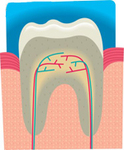Dental crowns or dental caps or tooth caps are a type of dental restoration which when cemented into place, encase the entire visible portion of the tooth and thus become the new tooth's outer surface. A dental crown may be recommended by a dentist for anyone of the following reasons: to restore a tooth to its original shape, to improve the cosmetic appearance of the tooth or to strengthen a tooth, to cover a dental implant.
 The procedure involves a dentist preparing the tooth and making a moulded impression of the teeth and sending it to the dental laboratory. Once completed, the crown is cemented .In the meantime, a temporary crown is created to temporarily protect the tooth. Using CAD/CAM technology, if a 3-d picture of the tooth is taken, and then there is no need for temporary tooth.
The procedure involves a dentist preparing the tooth and making a moulded impression of the teeth and sending it to the dental laboratory. Once completed, the crown is cemented .In the meantime, a temporary crown is created to temporarily protect the tooth. Using CAD/CAM technology, if a 3-d picture of the tooth is taken, and then there is no need for temporary tooth.
Dental crowns can be made from any one of the following materials:
Metals: Metals used in crowns include gold alloys, other alloys or a base-metal alloy like nickel or chromium. Metal crowns last the longest and can withstand biting and chewing forces and seldom chip or break. Metallic crowns are a good choice for out of sight mortar. The only drawback is their colour.
Porcelain-fused-to – metal dental crowns can be colour matched to the adjacent teeth. More wearing to the opposing teeth occurs with this type of crowns and its porcelain portion may chip or break. Next to all-ceramic crowns, these types of crowns look most like normal teeth. This type of dental crowns can be a good choice for front or back teeth.
All-resin dental crowns are less expensive than other types of crowns but are more prone to fractures than porcelain -fused -to-metal crowns.
All ceramic or all-porcelain: they provide the best natural colour match among all crown types and are suitable for people with metal allergies. For front teeth, all ceramic crowns are a good choice. Preparing a tooth for a crown usually includes two stages, examining and preparing the tooth and placement of the permanent crown.
When there is decay in a tooth, the dentist usually recommends providing the tooth with an intracoronal restoration, which consists of a dental material that will be met totally within the confines of the remaining tooth structure. This is referred to "cavity filling”. An advantage of crowning a tooth over restoration is that crowns give much more protection against future fracture or recurrent decay.
The situations which warrant a dental crown can be dental implants, endodontically treated tooth, removable partial denture and for aesthetic purposes. Even though any type of dental restoration will not last forever, the average lifespan of a crown is around ten years if properly cared for and can last up to the life of a patient.
The lifespan of the crown mainly depends on the oral hygiene performed by the patient and also on the skill of the dentist and lab technician and the material used. Full gold crowns last the longest.
The main disadvantages of dental crown are the high costs involved and irreversible tooth preparation and the advantages are long-term durability and evidence based success compared to other restorations. Crowns have a relatively much higher fee. Porcelain costs about 20%more than full gold crowns and the cost is the limiting factor that precludes greater use of the procedure.
By Lesley Lyon









Fin McDonald - 8 years ago
For most people $1600 per crown is simply too much money. There are some cool things happening with new dental ceramic materials. Zirconium and Lithium Disilicate seem to be the two getting the most air time in dental circles. They are still so expensive. If you can’t afford a crown you should ask if you dentist provides the One Visit Crown. A NZ based company Rhondium invented it and they say it can reduce the cost to the patient.